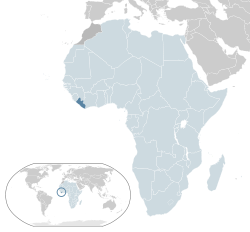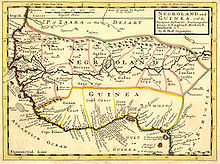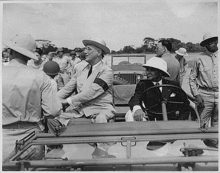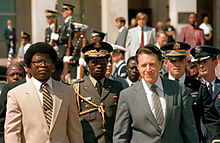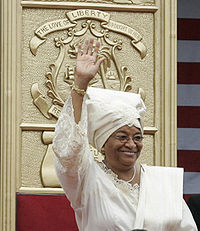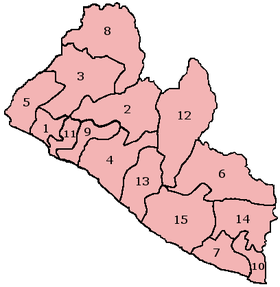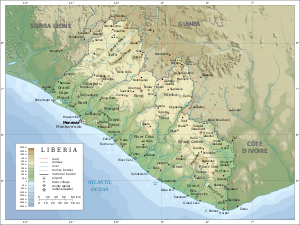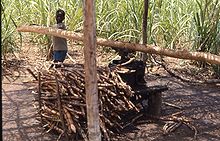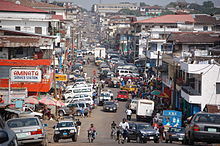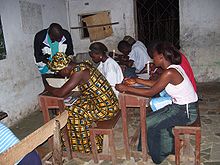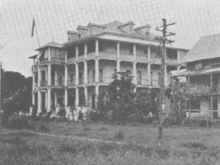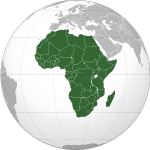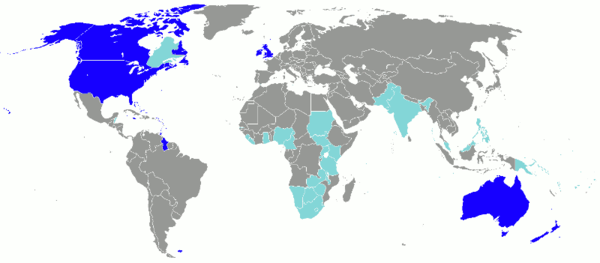- Liberia
-
This article is about the country in Africa. For the city, see Liberia, Costa Rica.
Republic of Liberia 

Flag Coat of Arms Motto: The love of liberty brought us here Anthem:
"All Hail, Liberia, Hail!"Location of Liberia within the African UnionCapital
(and largest city)Monrovia
6°19′N 10°48′W / 6.317°N 10.8°WOfficial language(s) English Demonym Liberian Government Unitary presidential constitutional republic - President Ellen Johnson Sirleaf - Vice President Joseph Boakai - Speaker of the House Alex J. Tyler - Chief Justice Johnnie Lewis Legislature Legislature of Liberia - Upper House Senate - Lower House House of Representatives Formation - Established by the American Colonization Society 1822 - Independence 26 July 1847 - Current constitution 6 January 1986 Area - Total 111,369 km2 (103rd)
43,000 sq mi- Water (%) 13.514 Population - 2011 estimate 3,786,764[1] - 2008 census 3,476,608 (130th) - Density 35.5/km2 (180th)
92.0/sq miGDP (PPP) 2010 estimate - Total $1.691 billion[2] - Per capita $392[2] GDP (nominal) 2010 estimate - Total $974 million[2] - Per capita $226[2] HDI (2010)  0.300 (low) (162nd)
0.300 (low) (162nd)Currency Liberian dollar1 ( LRD)Time zone GMT - Summer (DST) not observed (UTC) Drives on the right ISO 3166 code LR Internet TLD .lr Calling code 231 1 United States dollar also legal tender. Liberia
 i/laɪˈbɪəriə/, officially the Republic of Liberia, is a country in West Africa. It is bordered by Sierra Leone on the west, Guinea on the north and Côte d'Ivoire on the east. Liberia's coastline is composed of mostly mangrove forests while the more sparsely populated inland consists of forests that open to a plateau of drier grasslands. The country possesses 40% of the remaining Upper Guinean rainforest. Liberia has a hot equatorial climate, with significant rainfall during the May to October rainy season and harsh harmattan winds the remainder of the year. Liberia covers an area of 111,369 km2 (43,000 sq mi) and is home to about 3.7 million people. English is the official language, while over 30 indigenous languages are spoken within the country.
i/laɪˈbɪəriə/, officially the Republic of Liberia, is a country in West Africa. It is bordered by Sierra Leone on the west, Guinea on the north and Côte d'Ivoire on the east. Liberia's coastline is composed of mostly mangrove forests while the more sparsely populated inland consists of forests that open to a plateau of drier grasslands. The country possesses 40% of the remaining Upper Guinean rainforest. Liberia has a hot equatorial climate, with significant rainfall during the May to October rainy season and harsh harmattan winds the remainder of the year. Liberia covers an area of 111,369 km2 (43,000 sq mi) and is home to about 3.7 million people. English is the official language, while over 30 indigenous languages are spoken within the country.Liberia is one of only two modern countries in Sub-Saharan Africa without roots in the European Scramble for Africa. Beginning in 1820, the region was colonized by freed American slaves with the help of the American Colonization Society, a private organization that believed ex-slaves would have greater freedom and equality in Africa. Slaves freed from slave ships were also sent there instead of being repatriated to their countries of origin. In 1847, these colonists founded the Republic of Liberia, establishing a government modeled on that of the United States and naming the capital city Monrovia after James Monroe, the fifth president of the United States and a prominent supporter of the colonization. The colonists, known as Americo-Liberians, monopolized the political and economic sectors of the country despite comprising only a small percentage of the largely indigenous population.
The country began to modernize in the 1940s following investment by the United States during World War II and economic liberalization under President William Tubman. Liberia was a founding member of the United Nations and the Organization of African Unity. A military coup overthrew the Americo-Liberian establishment in 1980, marking the beginning of political and economic instability and two successive civil wars that left approximately 250,000 people dead and devastated the country's economy. A 2003 peace deal led to democratic elections in 2005. Today, Liberia is recovering from the lingering effects of the civil war and related economic dislocation, with about 85% of the population living below the international poverty line.
Contents
History
Main article: History of LiberiaThe Pepper Coast has been inhabited at least as far back as the 12th century, perhaps earlier. Mende-speaking people expanded westward from Sudan, forcing many smaller ethnic groups southward towards the Atlantic ocean. The Dei, Bassa, Kru, Gola and Kissi were some of the earliest recorded arrivals.[3] This influx was compounded by the decline of the Western Sudanic Mali Empire in 1375 and later in 1591 with the Songhai Empire. Additionally, inland regions underwent desertification, and inhabitants were pressured to move to the wetter coast. These new inhabitants brought skills such as cotton spinning, cloth weaving, iron smelting, rice and sorghum cultivation, and social and political institutions from the Mali and Songhai Empires.[4] Shortly after the Manes conquered the region, the Vai people of the former Mali Empire immigrated to into the Grand Cape Mount region. The ethnic Kru opposed the influx of Vai, forming an alliance with the Manes to stop further influx of Vai.
People along the coast built canoes and traded with other West Africans from Cap-Vert to the Gold Coast. Between 1461 and late 17th century, Portuguese, Dutch and British traders had contacts and trading posts in the region. The Portuguese named the area Costa da Pimenta, meaning Pepper Coast but later translated as Grain Coast, because of the abundance of grains of melegueta pepper. European traders would barter various commodities and goods with local people. When the Kru began trading with Europeans, they initially traded in commodities, but later they actively participated in the African slave trade.
In 1820, the American Colonization Society (ACS) began sending black volunteers to the Pepper Coast to establish a colony for freed American slaves.[5] The ACS, a private organization supported by prominent American politicians such as Henry Clay and James Monroe, believed repatriation was preferable to emancipation of slaves.[6] Similar organizations established colonies in Mississippi-in-Africa and the Republic of Maryland, which were later annexed by Liberia. On July 26, 1847, the settlers issued a Declaration of Independence and promulgated a constitution, which created the independent Republic of Liberia.[7][8]
The new nation largely excluded the indigenous population from the country's affairs. The 1865 Ports of Entry Act prohibited foreign commerce with the inland tribes.[7] In 1877, the Americo-Liberian True Whig Party monopolized political power in the country.[9] Competition for office was usually contained within the party, whose nomination virtually ensured election.[9] Pressure from the United Kingdom and France led to a loss of Liberia's claims to extensive territories, which were annexed by the colonial powers.[10] Economic development was hindered by the decline of markets for Liberian goods in the late 19th century and by indebtedness on a series of international loans.[11] In Liberia's early years, the Americo-Liberian settlers periodically encountered stiff and sometimes violent opposition from indigenous Africans, who were excluded from citizen's rights in the new Republic until 1904.[12]
In the mid-20th century, Liberia gradually began to modernize with American assistance. Both the Freeport of Monrovia and Roberts International Airport were built by U.S. personnel through the Lend-Lease program during World War II.[13] President William Tubman encouraged foreign investment in the country, resulting in the second-highest rate of economic growth in the world during the 1950s.[13] Liberia also began to take a more active role in international affairs. It was a founding member of the United Nations in 1945 and became a vocal critic of the South African apartheid regime.[14] Liberia also served as a proponent both of African independence from the European colonial powers and of Pan-Africanism, helping to found the Organization of African Unity.[15]
On April 12, 1980, a military coup led by Master Sergeant Samuel Doe of the indigenous Krahn ethnic group overthrew and killed President William R. Tolbert, Jr.. Doe and the other plotters later executed a majority of Tolbert's cabinet and other Americo-Liberian government officials and True Whig Party members.[16] The coup leaders formed the People's Redemption Council (PRC) to govern the country.[16] A strategic Cold War ally, Doe received significant financial backing from the United States, even as critics condemned the PRC for corruption and political repression.[16] After the country adopted a new constitution in 1985, Doe was elected president in subsequent elections that were internationally condemned as fraudulent.[16] On November 12, 1985, a failed counter-coup was launched by Thomas Quiwonkpa, whose soldiers briefly occupied the national radio station.[17] Government repression intensified in response, as Doe's troops massacred members of the Gio and Mano ethnic groups in Nimba County.[17]
The National Patriotic Front of Liberia, a rebel group led by Charles Taylor, launched an insurrection in December 1989 against Doe's government with the backing of neighboring countries such as Burkina Faso and Côte d'Ivoire, triggering the First Liberian Civil War.[18] By September 1990, Doe's forces controlled only a small area just outside the capital, and Doe was captured and executed that month by rebel forces.[19] The rebels soon split into various factions fighting one another, and the Economic Community Monitoring Group under the Economic Community of West African States organized a military task force to intervene in the crisis.[19] From 1989 to 1996 one of Africa's bloodiest civil wars ensued, claiming the lives of more than 200,000 Liberians and displacing a million others into refugee camps in neighboring countries.[12] Following a peace deal between the warring parties in 1995, Taylor was elected president in 1997.[19]
Under Taylor's regime, Liberia became internationally known as a pariah state due to his use of blood diamonds and illegal timber exports to fund the Revolutionary United Front in the Sierra Leone Civil War.[20] The Second Liberian Civil War began in 1999 when Liberians United for Reconciliation and Democracy, a rebel group based in the northwest of the country, launched an armed insurrection against Taylor.[21] In March 2003, a second rebel group, Movement for Democracy in Liberia, began launching attacks against Taylor from the southeast.[21] Peace talks between the factions began in Accra in June of that year, and Taylor was indicted by the Special Court for Sierra Leone for crimes against humanity that same month.[20] By July 2003, the rebels had launched an assault on Monrovia.[22] Under heavy pressure from the international community and the domestic Women of Liberia Mass Action for Peace movement,[23] Taylor resigned in August and went into exile in Nigeria,[24] and a peace deal was signed later that month.[25] The United Nations Mission in Liberia began arriving in September 2003 to provide security and monitor the peace accord,[26] and an interim government took power the following October.[27]
The subsequent 2005 elections were internationally regarded as the most free and fair in Liberian history.[28] Ellen Johnson Sirleaf, a Harvard-trained economist and former Minister of Finance, was elected as the first female president in Africa.[28] Upon her inauguration, Sirleaf requested the extradition of Taylor from Nigeria and immediately handed him over to the SCSL for trial in The Hague.[29][30] In 2006, the government established a Truth and Reconciliation Commission to address the causes and crimes of the civil war.[31]
Politics
Main article: Politics of LiberiaThe government of Liberia, modeled on the government of the United States, is a unitary constitutional republic and representative democracy as established by the Constitution. The government has three co-equal branches of government: executive, headed by the president; legislative, consisting of the bicameral Legislature of Liberia; and judicial, made up of the Supreme Court and several lower courts.
The president serves as head of government, head of state and the commander-in-chief of the Armed Forces of Liberia.[1] Among the other duties of the president are to sign or veto legislative bills, grant pardons, and appoint Cabinet members, judges and other public officials. Together with the vice president, the president is elected to a six-year term by majority vote in a two-round system and can serve up to two terms in office.[1]
The Legislature is composed of the Senate and the House of Representatives. The House, led by a speaker, has 64 members apportioned among the 15 counties on the basis of the national census, with each county receiving a minimum of two members.[1] Each House member represents an electoral district within a county as drawn by the National Elections Commission and is elected by a plurality of the popular vote of their district in to a six-year term. The Senate is made up of two senators from each county for a total of 30 senators.[1] Senators serve nine-year terms and are elected at-large by a plurality of the popular vote .[1] The vice president serves as the President of the Senate, with a President pro tempore serving in his absence.
Liberia's highest judicial authority is the Supreme Court, made up of five members and headed by the Chief Justice of Liberia. Members are nominated to the court by the president and are confirmed by the Senate, serving until the age of 70. The judiciary is further divided into circuit and speciality courts, magistrate courts and justices of the peace.[32] The judicial system follows the Anglo-American common law.[33] An informal system of traditional courts still exists within the rural areas of the country, with trial by ordeal remaining common despite being officially outlawed.[32]
Between 1877 and 1980, the government was dominated by the True Whig Party.[9] Today, over 20 political parties are registered in the country, based largely around personalities and ethnic groups.[28] Most parties suffer from poor organizational capacity.[28] The 2005 elections marked the first time that the president's party did not gain a majority of seats in the Legislature.[28]
Liberia scored a 3.3 on a scale from 10 (highly clean) to 0 (highly corrupt) on the 2010 Corruption Perceptions Index, ranking 87th of 178 countries worldwide and 11th of 47 in Sub-Saharan Africa.[34] This score represented a significant improvement since 2007, when the country scored 2.1 and ranked 150th of 180 countries.[35] When seeking attention of a selection of service providers 89% of Liberians had to pay a bribe, the highest national percentage in the world according to the organization's 2010 Global Corruption Barometer.[36]
Counties and districts
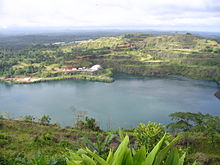 View of a lake in Bomi County
View of a lake in Bomi County
Liberia is divided into 15 counties, which are subdivided into districts, and further subdivided into clans. The oldest counties are Grand Bassa and Montserrado, both founded in 1839 prior to Liberian independence. Gbarpolu is the newest county, created in 2001. Nimba is the largest of the counties in size at 4,460 square miles (11,551 km2), while Montserrado is the smallest at 737 square miles (1,909 km2).[37] Montserrado is also the most populous county with 1,144,806 residents as of the 2008 census.[37]
The fifteen counties are administered by superintendents appointed by the president. The Constitution calls for the election of mayors and various chiefs at the county and local level, but these elections have not taken place since 1985 due to war and financial constraints.[38] In 2008, the Supreme Court ruled in favor of allowing the president to appoint mayors until the country could afford to hold municipal elections.[38]
County Capital Population (2008)[37] Area[37] Created Bomi Tubmanburg 82,036 750 sq mi (1,942 km2) 1984 Bong Gbarnga 328,919 3,387 sq mi (8,772 km2) 1964 Gbarpolu Bopulu 83,758 3,741 sq mi (9,689 km2) 2001 Grand Bassa Buchanan 224,839 3,064 sq mi (7,936 km2) 1839 Grand Cape Mount Robertsport 129,055 1,993 sq mi (5,162 km2) 1844 Grand Gedeh Zwedru 126,146 4,048 sq mi (10,484 km2) 1964 Grand Kru Barclayville 57,106 1,504 sq mi (3,895 km2) 1984 Lofa Voinjama 270,114 3,854 sq mi (9,982 km2) 1964 Margibi Kakata 199,689 1,010 sq mi (2,616 km2) 1985 Maryland Harper 136,404 887 sq mi (2,297 km2) 1857 Montserrado Bensonville 1,144,806 737 sq mi (1,909 km2) 1839 Nimba Sanniquellie 468,088 4,460 sq mi (11,551 km2) 1964 River Cess River Cess 65,862 2,160 sq mi (5,594 km2) 1985 River Gee Fish Town 67,318 1,974 sq mi (5,113 km2) 2000 Sinoe Greenville 104,932 3,914 sq mi (10,137 km2) 1843 Geography
Main article: Geography of LiberiaLiberia is situated in West Africa, bordering the North Atlantic Ocean to the country's southwest. It lies between latitudes 4° and 9°N, and longitudes 7° and 12°W.
The landscape is characterized by mostly flat to rolling coastal plains that contain mangroves and swamps, which rise to a rolling plateau and low mountains in the northeast.[39] Tropical rainforests cover the hills, while elephant grass and semi-deciduous forests make up the dominant vegetation in the northern sections.[39] The equatorial climate is hot year-round with heavy rainfall from May to October with a short interlude in mid-July to August.[39] During the winter months of November to March, dry dust-laden harmattan winds blow inland, causing many problems for residents.[39]
Liberia's watershed tends to move in a southwestern pattern towards the sea as new rains move down the forested plateau off the inland mountain range of Guinée Forestière, in Guinea. Cape Mount near the border with Sierra Leone receives the most precipitation in the nation.[39] The country's main northwestern boundary is traversed by the Mano River while its southeast limits are bounded by the Cavalla River.[39] Liberia's three largest rivers are St. Paul exiting near Monrovia, the river St. John at Buchanan and the Cestos River, all of which flow into the Atlantic. The Cavalla is the longest river in the nation at 320 miles (515 km).[39]
The highest point wholly within Liberia is Mount Wuteve at 4,724 feet (1,440 m) above sea level in the northwestern Liberia range of the West Africa Mountains and the Guinea Highlands.[39] However, Mount Nimba near Yekepa, is higher at 5,748 feet (1,752 m) above sea level but is not wholly within Liberia as Nimba shares a border with Guinea and Côte d'Ivoire (Ivory Coast) and is their tallest mountain as well.[40]
Economy
Main article: Economy of LiberiaLiberia is one of the world's poorest countries, with a formal employment rate of only 15%.[32] In 2010, the country's nominal GDP was US$974 million, while nominal GDP per capita stood at US$226, the third-lowest in the world.[2] Historically, the Liberian economy has depended heavily on foreign aid, foreign direct investment and exports of natural resources such as iron ore, rubber and timber.[39]
Following a peak in growth in 1979, the Liberian economy began a steady decline due to economic mismanagement following the 1980 coup.[41] This decline was accelerated by the outbreak of civil war in 1989; GDP was reduced by an estimated 90% between 1989 and 1995, one of the fastest declines in history.[41] Upon the end of the war in 2003, GDP growth began to accelerate, reaching 9.4% in 2007.[42] The global financial crisis slowed GDP growth to 4.6% in 2009,[42] though a strengthening agricultural sector led by rubber and timber exports increased growth to 5.1% in 2010 and an expected 7.3% in 2011, making the economy one of the 20 fastest growing in the world.[43][44] Current impediments to growth include a small domestic market, lack of adequate infrastructure, high transportation costs, poor trade links with neighboring countries and the high dollarization of the economy.[43] Liberia used the United States dollar as its currency from 1943 until 1982 and continues to use the U.S. dollar alongside the Liberian dollar.[45] Following a decrease in inflation beginning in 2003, inflation spiked in 2008 as a result of worldwide food and energy crises,[46] reaching 17.5% before declining to 7.4% in 2009.[42] Liberia's external debt was estimated in 2006 at approximately $4.5 billion, 800% of GDP.[41] As a result of bilateral, multilateral and commercial debt relief from 2007–2010, the country's external debt fell to $222.9 million by 2011.[47]
While official commodity exports declined during the 1990s as many investors fled the civil war, Liberia's wartime economy featured the exploitation of the region's diamond wealth.[48] The country acted as a major trader in Sierra Leonian blood diamonds, exporting over US$300 million in diamonds in 1999.[49] This led to a United Nations ban on Liberian diamond exports in 2001, which was lifted in 2007 following Liberia's accession to the Kimberley Process Certification Scheme.[50] In 2003, additional UN sanctions were placed on Liberian timber exports, which had risen from US$5 million in 1997 to over US$100 million in 2002 and were believed to be funding rebels in Sierra Leone.[51][52] These sanctions were lifted in 2006.[53] Due in large part to foreign aid and investment inflow following the end of the war, Liberia maintains a large account deficit, which peaked at nearly 60% in 2008.[43] Liberia gained observer status with the World Trade Organization in 2010 and is in the process of acquiring full member status.[54]
Liberia has the highest ratio of foreign direct investment to GDP in the world, with US$16 billion in investment since 2006.[44] Following the inauguration of the Sirleaf administration in 2006, the country signed several multi-billion dollar concession agreements in the iron ore and palm oil industries with numerous multinational corporations, including BHP Billiton, ArcelorMittal, and Sime Darby.[55] The Firestone Tire and Rubber Company has operated the world's largest rubber plantation in Liberia since 1926.[56] Liberia has also begun exploration for offshore oil; unproven oil reserves may be in excess of one billion barrels.[57] The government divided its offshore waters into 17 blocks and began auctioning off exploration licenses for the blocks in 2004, with further auctions in 2007 and 2009.[58][59][60] An additional 13 ultra-deep offshore blocks were demarcated in 2011 and planned for auction.[61] Among the companies to have won licenses are Repsol, Chevron, Anadarko and Woodside Petroleum.[62]
Due to its status as a flag of convenience, the country has the second-largest maritime registry in the world behind Panama, with 3,500 vessels registered under its flag accounting for 11% of ships worldwide.[63][64]
Infrastructure
Further information: Communications in Liberia and Transport in LiberiaDemographics
Main articles: Demographics of Liberia and Languages of LiberiaAs of the 2008 national census, Liberia was home to 3,476,608 people.[65] Of those, 1,118,241 lived in Montserrado County, the most populous county in the country and home to the capital of Monrovia, with the Greater Monrovia district home to 970,824 people.[65] Nimba County is the next most populous county with 462,026 residents.[65] As revealed in the 2008 census, Monrovia is more than four times more populous than all the county headquarters combined.[37] Prior to the 2008 census, the last census had been held in 1984 and listed the country's population as 2,101,628.[65] The population of Liberia was 1,016,443 in 1962 and increased to 1,503,368 in 1974.[37] As of 2006, Liberia has the highest population growth rate in the world (4.50% per annum). Similar to its neighbors, it has a large youth population, with half of the population under the age of 18.
The population includes 16 indigenous ethnic groups and various foreign minorities. Indigenous peoples comprise about 95% of the population, the largest of which are the Kpelle in central and western Liberia. Americo-Liberians, who are descendants of African-American settlers, make up 2.5%, and Congo people, descendants of repatriated Congo and Afro-Caribbean slaves who arrived in 1825, make up an estimated 2.5%.[1][66] There is also a sizable number of Lebanese, Indians, and other West African nationals who make up a significant part of Liberia's business community. A small minority of Liberians of European descent reside in the country.[1] The Liberian constitution restricts citizenship to only people of black African descent.[67]
31 indigenous languages are spoken within Liberia, none of which are a first language to more than a small percentage of the population.[68] English is the official language and serves as the lingua franca of the country.[69] Liberians speak a variety of dialects collectively known as Liberian English.[69]
Education
Main article: Education in LiberiaIn 2009, the literacy rate of Liberia was estimated at 59.1% (63.7% for males and 54.5% for females).[70] Primary and secondary education is free and compulsory from the ages of 6-16, though enforcement of attendance is lax.[71] On average, children attain 10 years of education (11 for boys and 8 for girls).[1] The country's education sector is hampered by inadequate schools and supplies, as well as a lack of qualified teachers.[72]
Higher education is provided by a number of public and private universities. The University of Liberia is the country's largest and oldest university. Located in Monrovia, the university opened in 1862 and today has six colleges, including a medical school and the nation's only law school, Louis Arthur Grimes School of Law.[73] In 2009, Tubman University in Harper, Maryland County became the second public university in Liberia.[74] Cuttington University, established by the Episcopal Church of the USA in 1889 in Suakoko, Bong County, is the nation's oldest private university. Since 2006, the government has also opened community colleges in Buchanan, Sanniquellie, and Voinjama.[75][76][77]
Religion
Main article: Religion in LiberiaAccording to the 2008 National Census, 85.5% of the population practices Christianity. Muslims comprise 12.2% of the population, largely coming from the Mandingo and Vai ethnic groups. Traditional indigenous religions are practiced by .5% of the population, while 1.5% subscribe to no religion. A small number of people are Bahá'í, Hindu, Sikh, or Buddhist. Concurrent participation in indigenous religious secret societies such as Poro and Sande is common, with some Sande societies practicing female genital mutilation.[78]
The Constitution provides for freedom of religion, and the government generally respects this right.[78] While separation of church and state is also mandated by the Constitution, Liberia is considered a de facto Christian state.[28] Public schools offer biblical studies, though parents may opt out their children. Commerce is prohibited by law on Sundays and major Christian holidays. The government does not require businesses or schools to excuse Muslims for Friday prayers.[78]
Health
In 2009, life expectancy in Liberia was estimated at 58 years.[79] With a fertility rate of 5.9 births per woman, the maternal mortality rate stood at 990 per 100,000 births in 2010.[80] A number of highly communicable diseases are widespread, including tuberculosis, diarrheal diseases and malaria. In 2007, HIV infection rates stood at 2% of the population aged 15–49 [81] whereas the incidence of tuberculosis was 420 per 100,000 people in 2008.[82] Liberia imports 90% of its rice, a staple food, and is extremely vulnerable to food shortages.[83] In 2007, 20.4% of children under the age of 5 were malnourished.[84] In 2008, only 17% of the population had access to adequate sanitation facilities.[85]
The civil war destroyed approximately 95% of the country's healthcare facilities.[86] In 2009, government expenditure on health care per capita was US$22,[87] accounting for 10.6% of total GDP.[88] In 2008, Liberia had only 1 doctor and 27 nurses per 100,000 people.[82]
Culture
Main article: Culture of LiberiaThe religious practices, social customs and cultural standards of the Americo-Liberians had their roots in the antebellum American South. The settlers wore top hat and tails and modeled their homes on those of Southern slaveowners.[89] Most Americo-Liberian men were members of the Masonic Order of Liberia, which became heavily involved in the nation's politics.[90]
Liberia has a long, rich history in textile arts and quilting, as the settlers brought with them their sewing and quilting skills. Liberia hosted National Fairs in 1857 and 1858 in which prizes were awarded for various needle arts. One of the most well-known Liberian quilters was Martha Ann Ricks,[91] who presented a quilt featuring the famed Liberian coffee tree to Queen Victoria in 1892. When President Ellen Johnson Sirleaf moved into the Executive Mansion, she reportedly had a Liberian-made quilt installed in her presidential office.[92]
A rich literary tradition has existed in Liberia for over a century. Edward Wilmot Blyden, Bai T. Moore, Roland T. Dempster and Wilton G. S. Sankawulo are among Liberia's more prominent authors.[93] Moore's novella Murder in the Cassava Patch is considered Liberia's most celebrated novel.[94]
Liberian cuisine heavily incorporates rice, the country's staple food. Other ingredients include cassava, fish, bananas, citrus fruit, plantains, coconut, okra and sweet potatoes.[95] Heavy stews spiced with habanero and scotch bonnet chillies are popular and eaten with fufu.[96] Liberia also has a tradition of baking imported from the United States that is unique in West Africa.[97]
Measurement system
Liberia is one of only three countries, along with the United States and Burma, that does not officially use the International System of Units.[98] The Liberian government has begun transitioning away from use of imperial units to the metric system.[99] However, this change has been gradual, with government reports concurrently using both imperial and metric units.[100][101] A 2008 report from the University of Tennessee stated that the changeover from imperial to metric measures was confusing to coffee and cocoa farmers.[99]
See also
- Outline of Liberia
- Index of Liberia-related articles
- Foreign relations of Liberia
References
- ^ a b c d e f g h i "Liberia". The World Factbook. Central Intelligence Agency. 2011. https://www.cia.gov/library/publications/the-world-factbook/geos/li.html. Retrieved July 20, 2011.
- ^ a b c d e "Liberia". International Monetary Fund. http://www.imf.org/external/pubs/ft/weo/2011/01/weodata/weorept.aspx?sy=2008&ey=2011&scsm=1&ssd=1&sort=country&ds=.&br=1&c=668&s=NGDPD%2CNGDPDPC%2CPPPGDP%2CPPPPC%2CLP&grp=0&a=&pr.x=38&pr.y=12. Retrieved 2011-04-30.
- ^ Runn-Marcos, K. T. Kolleholon, B. Ngovo, p. 5
- ^ Runn-Marcos, K. T. Kolleholon, B. Ngovo, p. 6
- ^ "Maps of Liberia 1830-1870" (Oct. 19, 1998). Library of Congress, Geography and Map Division. Retrieved September 1, 2009.
- ^ Maggie Montesinos Sale (1997). The slumbering volcano: American slave ship revolts and the production of rebellious masculinity, p.264. Duke University Press, 1997. ISBN 0-8223-1992-6
- ^ a b Johnston, Harry Hamilton; Stapf, Otto (1906). Liberia, Volume I. Hutchinson & Co,. ISBN 1-1433-1505-7. http://books.google.com/books?id=XTYbAAAAYAAJ&printsec=frontcover&source=gbs_ge_summary_r&cad=0#v=onepage&q&f=false.
- ^ Adekeye Adebajo, Liberia's Civil War: Nigeria, ECOMOG, and Regional Security in West Africa (2002), International Peace Academy, page 21.
- ^ a b c "The True Whig Ascendancy". Global Security. http://www.globalsecurity.org/military/library/report/1985/liberia_1_truewhigascend.htm. Retrieved July 23, 2011.
- ^ "Lost Markets". Global Security. http://www.globalsecurity.org/military/library/report/1985/liberia_1_lostterr.htm. Retrieved July 23, 2011.
- ^ "Lost Markets and Economic Decline". Global Security. http://www.globalsecurity.org/military/library/report/1985/liberia_1_lostmarkets.htm. Retrieved July 23, 2011.
- ^ a b "Liberia". U.S. State Department.
- ^ a b Marinelli, Lawrence (1964). "Liberia's Open Door Policy". The Journal of Modern African Studies 2 (1): 91–98.
- ^ "Africa: A Vote on Apartheid". Time. July 29, 1966. http://www.time.com/time/magazine/article/0,9171,899287,00.html. Retrieved July 20, 2011.
- ^ Adogamh, Paul G. (July 2008). "Pan-Africanism Revisited: Vision and Reality of African Unity and Development". African Review of Integration 2 (2). http://www.africa-union.org/root/ua/Newsletter/EA/Vol2%20No2/Adogamhe.pdf. Retrieved July 20, 2011.
- ^ a b c d "Global Connections: Liberia". PBS. 2002. http://www.pbs.org/wgbh/globalconnections/liberia/essays/uspolicy/. Retrieved July 20, 2011.
- ^ a b "World Notes". Time. November 25, 1985. http://www.time.com/time/magazine/article/0,9171,1050633,00.html. Retrieved July 22, 2011.
- ^ Ellis, Stephen (2001). The Mask of Anarchy Updated Edition: The Destruction of Liberia and the Religious Dimension of an African Civil War. NYU Press. pp. 75. ISBN 0-8147-2238-5.
- ^ a b c "Liberia country profile". BBC News. May 4, 2011. http://news.bbc.co.uk/2/hi/africa/country_profiles/1043500.stm. Retrieved July 23, 2011.
- ^ a b "Arrest warrant for Liberian leader". BBC News. June 4, 2003. http://news.bbc.co.uk/2/hi/africa/2961390.stm. Retrieved July 20, 2011.
- ^ a b "Indepth: Liberia, Land of the free". CBC News. July 23, 2009. http://www.cbc.ca/news/background/liberia/.
- ^ "Liberia's civil war: Fiddling while Monrovia burns". The Economist. July 24, 2003. http://www.economist.com/node/1944472?story_id=E1_TJQQQSN. Retrieved July 22, 2011.
- ^ "Profile: Leymah Gbowee - Liberia's 'peace warrior'". BBC News. October 7, 2011. http://www.bbc.co.uk/news/world-africa-15215312. Retrieved October 20, 2011.
- ^ Simmons, Ann M. (August 12, 2003). "Taylor resigns as president of Liberia, leaves the country". Baltimore Sune. http://articles.baltimoresun.com/2003-08-12/news/0308120316_1_charles-taylor-liberia-sierra-leone. Retrieved July 23, 2011.
- ^ "Liberian rebels sign peace deal". The Guardian. August 19, 2003. http://www.guardian.co.uk/world/2003/aug/19/westafrica. Retrieved July 23, 2011.
- ^ "Liberia: UNMIL extends deployment as more troops arrive". IRIN News. December 24, 2003. http://newsite.irinnews.org/Report.aspx?ReportID=47807. Retrieved July 23, 2011.
- ^ "Bryant takes power in Liberia". The Guardian. October 14, 2003. http://www.guardian.co.uk/world/2003/oct/14/westafrica. Retrieved July 23, 2011.
- ^ a b c d e f "Freedom in the World 2011 - Liberia". Freedom House. UNHCR. July 7, 2011. http://www.unhcr.org/refworld/docid/4e16b8f91a.html. Retrieved July 22, 2011.
- ^ "LIBERIA-NIGERIA: "Time to bring Taylor issue to closure," says Sirleaf". IRIN News. March 17, 2006. http://www.irinnews.org/report.aspx?reportid=58474. Retrieved July 23, 2011.
- ^ "Taylor Sent Off to Face War Crimes Charges". AFP. UNMIL. March 29, 2006. http://unmil.org/1article.asp?id=1157&zdoc=1. Retrieved July 23, 2011.
- ^ "LIBERIA: War-battered nation launches truth commission". IRIN Africa. http://www.irinnews.org/report.aspx?reportid=58220. Retrieved 2008-05-16.
- ^ a b c "Background Note: Liberia". Bureau of African Affairs. United States Department of State. March 8, 2011. http://www.state.gov/r/pa/ei/bgn/6618.htm.
- ^ Liberia in Perspective: An Orientation Guide (2006) Defense Language Institute Foreign Language Center, page 2
- ^ "2010 Corruption Perceptions Index". Transparency International. October 26, 2010. http://www.transparency.org/policy_research/surveys_indices/cpi/2010. Retrieved July 22, 2011.
- ^ "Corruption Perceptions Index 2007". Transparency International. 2007. http://www.transparency.org/policy_research/surveys_indices/cpi/2007. Retrieved July 22, 2011.
- ^ "Global Corruption Barometer 2010". Transparency International. December 9, 2010. http://www.transparency.org/policy_research/surveys_indices/gcb/2010/results. Retrieved July 22, 2011.
- ^ a b c d e f "2008 National Population and Housing Census: Preliminary Results". Government of the Republic of Liberia. 2008. http://www.emansion.gov.lr/doc/census_2008provisionalresults.pdf. Retrieved 2008-10-14.
- ^ a b "Liberia cannot afford local polls". BBC News. January 14, 2008. http://news.bbc.co.uk/2/hi/7187906.stm.
- ^ a b c d e f g h i Bateman, Graham; Victoria Egan, Fiona Gold, and Philip Gardner (2000). Encyclopedia of World Geography. New York: Barnes & Noble Books. p. 161. ISBN 1566192919.
- ^ Financial Time's World Desk Reference (2004) Dorling Kindersley Publishing. p 368
- ^ a b c "The Challenges of Post-War Reconstruction - the Liberian Experience". Government of Liberia. allAfrica.com. June 13, 2011. http://allafrica.com/stories/201106140356.html.
- ^ a b c "Report for Selected Countries and Subjects: Liberia". International Monetary Fund. June 20, 2011. http://www.imf.org/external/pubs/ft/weo/2011/01/weodata/weorept.aspx?pr.x=41&pr.y=12&sy=2000&ey=2016&scsm=1&ssd=1&sort=country&ds=.&br=1&c=668&s=NGDP_RPCH%2CPCPIPCH&grp=0&a=.
- ^ a b c "IMF Country Report No. 10/37". International Monetary Fund. 2010. http://www.imf.org/external/pubs/ft/scr/2010/cr10373.pdf.
- ^ a b "Liberian President: Government and People are Partners in Progress". Africa Governance Initiative. January 27, 2011. http://www.tonyblairoffice.org/africa/news-entry/liberian-president-government-and-people-are-partners-in-progress/.
- ^ "Liberia Economic Recovery Assessment". USAID. July 2008. https://docs.google.com/viewer?a=v&q=cache:rjgZxrEkytAJ:www.countrycompass.com/_docs/assessments/Liberia_Economic_Recovery_Assessment.pdf+Liberian+dollar+1982&hl=en&gl=us&pid=bl&srcid=ADGEESgB5jM-McEY_lEOfi7dtjUAbUY3FHNMS-1b7c1mewxokLnC7PucnxlcZgbC4H60-44s9Kyw4SlVD0s8pI0lznK8MH_FSOPkOAEW8OgbhuDeI2kiEZ81wf4E0kNLQHndpFSE3jFO&sig=AHIEtbRULHwk2ifRoYIE__U6MRXyGwsreQ.
- ^ "Quarter Three Fiscal Outturn, Fiscal Year 2010/11". Ministry of Finance. May 2011. http://mof.gov.lr/doc/Published%20Fiscal%20Outturns.pdf.
- ^ "Second Quarter 2010/2011 Public Debt Management Report". Debt Management Unit. Ministry of Finance. March 25, 2011. http://mof.gov.lr/doc/2nd%20Qrt%20Debt%20Management%20Report.pdf.
- ^ "Liberia's diamond links". BBC News. July 18, 2000. http://news.bbc.co.uk/2/hi/africa/839206.stm.
- ^ "CBC News Indepth: Liberia". CBC News. March 29, 2006. http://www.cbc.ca/news/background/liberia/.
- ^ "Liberia restarts diamond industry". USA Today. May 1, 2007. http://www.usatoday.com/news/world/2007-05-01-liberia_N.htm.
- ^ "Bloody timber off the market". Greenpeace. May 7, 2003. http://www.greenpeace.org/international/en/news/features/bloody-timber-off-the-market/.
- ^ Strieker, Gary (January 13, 2002). "U.N. mulls embargo on Liberian timber". CNN. http://www.edition.cnn.com/2002/TECH/science/01/13/liberian.timber/index.html.
- ^ Xu, Chenni (June 20, 2006). "UN Lifts Liberia Timber Sanctions". Voice of America. http://www.voanews.com/english/news/a-13-2006-06-20-voa64.html.
- ^ "Liberia gains WTO observer status". Star Radio Liberia. March 17, 2010. http://www.starradio.org.lr/content/view/15063/59/.
- ^ "Government Announces Agreement with Chevron to Explore Liberian Waters". allAfrica.com. August 27, 2010. http://allafrica.com/stories/201008271043.html.
- ^ "Firestone and Liberia – Company History". Firestone Natural Rubber Company. http://www.firestonenaturalrubber.com/company_history.htm.
- ^ "Liberia may have over 1 bln barrels in oil resources". Reuters Africa. November 3, 2009. http://af.reuters.com/article/southAfricaNews/idAFWEA839820091103.
- ^ "NOCAL 2004 Liberia Offshore Bid Round Announcement". Business Wire. February 2, 2004. http://www.businesswire.com/news/home/20040202005192/en/NOCAL-2004-Liberia-Offshore-Bid-Announcement.
- ^ Pearson, Natalie Obiko (December 10, 2007). "Liberia Opens Bidding for 10 Offshore Oil Blocks". RigZone. http://www.rigzone.com/news/article.asp?a_id=53828.
- ^ "Third Liberian Offshore Petroleum Licensing Round 2009". Deloitte Petroleum Services. Deloitte. August 27, 2009. https://www.psg.deloitte.com/NewsLicensingRounds_LR_0909.asp.
- ^ Toweh, Alphonso (July 21, 2011). "Liberia marks out new oil blocks, auction seen soon". Reuters. http://af.reuters.com/article/topNews/idAFJOE76K01J20110721?sp=true. Retrieved August 22, 2011.
- ^ Konneh, Ansu (August 30, 2010). "Chevron, Liberia Sign Deepwater Offshore Exploration Agreement". Bloomberg News. http://www.bloomberg.com/news/2010-08-30/chevron-liberia-sign-deepwater-offshore-exploration-agreement.html.
- ^ Schoenurl, John W. (August 11, 2003). "Liberian shipping draws scrutiny". msnbc.com. http://www.msnbc.msn.com/id/3072983/t/liberian-shipping-draws-scrutiny/.
- ^ "About the Liberian Registry". Liberian Registry. http://www.liscr.com/liscr/AboutUs/AboutLiberianRegistry/tabid/206/Default.aspx.
- ^ a b c d Liberia Institute of Statistics and Geo-Information Services (May 2009). "2008 National Population and Housing Census Final Results: Population by County". 2008 Population and Housing Census. Republic of Liberia. http://www.emansion.gov.lr/doc/Population_by_County.pdf. Retrieved 2009-06-10.
- ^ "Liberia's Ugly Past: Re-writing Liberian History". Theperspective.org. http://www.theperspective.org/rewriting_history.html. Retrieved 2010-01-03.
- ^ "Lebanese demand Liberia poll rights". BBC News. 2005-07-22. http://news.bbc.co.uk/2/hi/africa/4703029.stm.
- ^ "Languages of Liberia". Ethnologue. 2009. http://www.ethnologue.com/show_country.asp?name=liberia. Retrieved July 22, 2011.
- ^ a b Moore, Jina (October 19, 2009). "Liberia: Ma Ellen talk plenty plenty Liberian English". Pulitzer Center on Crisis Reporting. http://pulitzercenter.org/blog/untold-stories/liberia-ma-ellen-talk-plenty-plenty-liberian-english. Retrieved July 22, 2011.
- ^ "Education profile - Liberia". Institute for Statistics. UNESCO. 2009. http://stats.uis.unesco.org/unesco/TableViewer/document.aspx?ReportId=121&IF_Language=eng&BR_Country=4300&BR_Region=40540. Retrieved July 20, 2011.
- ^ "LIBERIA: Go to school or go to jail". IRN. UN Office for the Coordination of Humanitarian Affairs. 21 September 2007. http://www.irinnews.org/Report.aspx?ReportId=74422. Retrieved 2009-04-08.
- ^ Trawally, Sidiki; Reeves, Derek (2009). "Making Quality Education Affordable And Assessable To All – Prez. Sirleaf’s Vision With Passion". Lift Liberia. http://www.liftliberia.gov.lr/press.php?news_id=100&related=Press%20Release. Retrieved July 20, 2011.
- ^ Jallah, David A. B. “Notes, Presented by Professor and Dean of the Louis Arthur Grimes School of Law, University of Liberia, David A. B. Jallah to the International Association of Law Schools Conference Learning From Each Other: Enriching the Law School Curriculum in an Interrelated World Held at Soochow University Kenneth Wang School of Law, Suzhou, China, October 17-19, 2007.” International Association of Law Schools. Retrieved on September 1, 2008.
- ^ "Ellen Describes Tubman University's Opening As PRS Success". The New Dawn. March 3, 2010. http://www.thenewdawnliberia.com/index.php?option=com_content&view=article&id=340:ellen-describes-tubman-universitys-opening-as-prs-success&catid=3:general&Itemid=68. Retrieved July 22, 2010.
- ^ "Remarks by H.E. President Ellen Johnson Sirleaf At Official Launch and Fundraising Program Of the Grand Bassa Community College". The Executive Mansion. October 21, 2010. http://www.emansion.gov.lr/doc/20101023President_Remarks_GBCC_Launch_Ground_Breaking.pdf. Retrieved July 22, 2011.
- ^ Fahn, Peter A. (July 7, 2011). "Government Moves Ahead With Education Decentralization Plans". Government Moves Ahead with Education Decentralization Plans. http://www.micat.gov.lr/index.php?option=com_content&view=article&id=156:government-moves-ahead-with-education-decentralization-plans&catid=47:new-liberia&Itemid=91. Retrieved August 3, 2011.
- ^ "July 26 Celebrations Kick Off in Lofa As President Sirleaf Arrives". The Executive Mansion. July 25, 2011. http://www.emansion.gov.lr/press.php?news_id=1951. Retrieved July 26, 2011.
- ^ a b c d "International Religious Freedom Report 2010: Liberia". United States Department of State. November 17, 2010. http://www.state.gov/g/drl/rls/irf/2010/148698.htm. Retrieved July 22, 2011.
- ^ "Date: Life expectancy at birth, total (years)". World Bank. http://data.worldbank.org/indicator/SP.DYN.LE00.IN. Retrieved July 22, 2011.
- ^ "The State of the World's Midwifery 2011: Liberia". United Nations Population Fund. http://www.unfpa.org/sowmy/resources/docs/country_info/profile/en_Liberia_SoWMy_Profile.pdf. Retrieved August 2, 2011.
- ^ "Data: Prevalence of HIV, total (% of population ages 15-49).". The World Bank. http://data.worldbank.org/indicator/SH.DYN.AIDS.ZS/countries. Retrieved 2011-02-23.
- ^ a b "Liberia: Health profile". World Health Organization. http://www.who.int/gho/countries/lbr.pdf. Retrieved 2011-02-23.
- ^ "Liberia: Nurtitional "crisis" in Monrovia". Integrated Regional Information Networks. UN Office for the Coordination of Humanitarian Affairs. http://www.irinnews.org/IndepthMain.aspx?InDepthID=72&ReportID=77811. Retrieved 2011-02-24.
- ^ "Data: Malnutrition prevalence, weight for age (% of children under 5). The". World Bank. http://data.worldbank.org/indicator/SH.STA.MALN.ZS/countries. Retrieved 2011-02-23.
- ^ "Data: Improved sanitation facilities (% of population with access)". The World Bank. http://data.worldbank.org/indicator/SH.STA.ACSN/countries. Retrieved 2011-02-23.
- ^ "Liberia: Breathing Life into ailing healthcare system". Integrated Regional Information Networks. UN Office for the Coordination of Humanitarian Affairs. http://www.irinnews.org/report.aspx?reportid=60788. Retrieved 2011-02-24.
- ^ "Data: Health expenditure per capita (current US$)". World Bank. http://data.worldbank.org/indicator/SH.XPD.PCAP/countries. Retrieved 2011-02-23.
- ^ "Data: Health expenditure, total (% of GDP)". World Bank. http://data.worldbank.org/indicator/SH.XPD.TOTL.ZS/countries. Retrieved 2011-02-23.
- ^ Wiltz, Teresa (December 2, 2010). "Liberia: War-Weary, With Echoes of Old Dixie". The Root. http://www.theroot.com/views/liberia-war-weary-echoes-old-dixie. Retrieved July 23, 2011.
- ^ "Monrovia - Masonic Grand Lodge". Global Security. http://www.globalsecurity.org/military/world/liberia/monrovia-mason.htm. Retrieved July 23, 2011.
- ^ "Martha Ricks". National Portrait Gallery. http://www.npg.org.uk/live/search/portrait.asp?LinkID=mp63618&rNo=0&role=sit. Retrieved 2008-12-12.
- ^ "Liberia: It's the Little Things - A Reflection on Ellen Johnson Sirleaf's Journey to the Presidency". allAfrica.com. http://allafrica.com/stories/200603240593.html?page=2. Retrieved 2008-05-16.
- ^ Kamara, Varney (July 20, 2010). "Liberia: "Literature Must Be Given Priority"". The Analyst (allAfrica.com). http://allafrica.com/stories/201007200709.html. Retrieved July 23, 2011.
- ^ Doe, J. Kpanneh (October 31, 2000). "Baa Salaka: Sacrificial Lamb - A Book Review & Commentary". The Perspective. http://www.theperspective.org/bookreview.html. Retrieved July 23, 2011.
- ^ "Celtnet Liberian Recipes and Cookery". Celtnet Recipes. http://www.celtnet.org.uk/recipes/liberia.php. Retrieved July 23, 2011.
- ^ "Liberia". http://www.foodbycountry.com/Kazakhstan-to-South-Africa/Liberia.html. Retrieved July 23, 2011.
- ^ "The Baking Recipes of Liberia". Africa Aid. http://gwydion.weebly.com/liberian-baking.html. Retrieved July 23, 2011.
- ^ "CIA The World Factbook". Appendix G: Weights and Measures. US Central Intelligence Agency. 2010. https://www.cia.gov/library/publications/the-world-factbook/appendix/appendix-g.html. Retrieved 24 April 2010.
- ^ a b Dr. Michael D. Wilcox, Jr. Department of Agricultural Economics University of Tennessee (2008). "Reforming Cocoa and Coffee Marketing in Liberia". Presentation and Policy Brief. University of Tennessee. http://trend.ag.utk.edu/international/ReformingCocoaCoffeeMarketingLiberia.pdf. Retrieved 25 April 2010.
- ^ Government of Liberia (2008). "County Development Agendas". Government of the Republic of Liberia. http://www.emansion.gov.lr/content.php?sub=County%20Development%20Agendas&related=CDAs. Retrieved 1 May 2010.
- ^ Eugene H. Shannon (31 December 2009). "Annual report". Annual report. Liberian Ministry of Lands, Mines and Energy. http://www.molme.gov.lr/doc/Microsoft%20Word%20-%20Annual%20Report%20Jan%201%20-%20Dec%2031%202009.pdf. Retrieved 1 May 2010.
- Bibliography
- Gilbert, Erik & Reynolds, Jonathan T (October 2003). Africa in World History, From Prehistory to the Present (Paperback ed.). Prentice Hall. ISBN 978-0-13-092907-5.
- Merriam Webster's Geographical Dictionary: 3rd Edition (Paperback ed.). Merriam Webster Inc., Springfield. 1997. ISBN 0-87779-546-0.
- Dunn-Marcos, Robin; Kollehlon, Konia T.; Ngovo, Bernard; Russ, Emily (April 2005). Ranar, Donald A.. ed. "Liberians: An Introduction to their History and Culture" (pdf). Culture Profile (Center for Applied Linguistics) (19). http://www.cal.org/co/liberians/liberian_050406_1.pdf. Retrieved July 23, 2011.
- Tim Hetherington (2009). Long Story Bit By Bit: Liberia Retold. New York: Umbrage. ISBN 9781884167737.
- Graham Greene (1936). Journey Without Maps. Vintage. ISBN 978-0-09-928223-5.
- Gabriel I. H. Williams (July 6, 2006). Liberia: The Heart of Darkness. Trafford Publishing. ISBN 1-55369-294-2.
- Alan Huffman (2004). Mississippi in Africa: The Saga of the Slaves of Prospect Hill Plantation and Their Legacy in Liberia Today. Gotham Books. ISBN 9781592400447.
- John-Peter Pham (April 4, 2001). Liberia: Portrait of a Failed State. Reed Press. ISBN 1-59429-012-1.
- Barbara Greene (March 5, 1991). Too Late to Turn Back. Penguin. ISBN 0-14009-594-2.
- Further reading
- Great Tales of Liberia by Wilton Sankawulo. Dr. Sankawulo is the compiler of these tales from Liberia and about Liberian culture. Published by Editura Universitatii "Lucian Blaga";; din Sibiu, Romania, 2004. - ISBN 973-651-838-8
- Sundown at Dawn: A Liberian Odyssey by Wilton Sankawulo. Recommended by the Cultural Resource Center, Center for Applied Linguistics for its content concerning Liberian culture. ISBN 0-9763565-0-3
- To Liberia: Destiny's Timing, by Victoria Lang (Publish America, Baltimore, 2004, ISBN 1-4137-1829-9). A fast-paced gripping novel of the journey of a young Black couple fleeing America to settle in the African motherland of Liberia.
- Godfrey Mwakikagile, Military Coups in West Africa Since The Sixties, Chapter Eight: Liberia: 'The Love of Liberty Brought Us Here,' pp. 85 – 110, Nova Science Publishers, Inc., Huntington, New York, 2001; Godfrey Mwakikagile, The Modern African State: Quest for Transformation, Chapter One: The Collapse of A Modern African State: Death and Rebirth of Liberia, pp. 1 – 18, Nova Science Publishers, Inc., 2001.
- Redemption Road: The Quest for Peace and Justice in Liberia (A Novel) by Elma Shaw, with a Foreword by President Ellen Johnson Sirleaf. (Cotton Tree Press, 2008, ISBN 978-0-9800774-0-7)
- House at Sugar Beach: In Search of a Lost African Childhood by Helene Cooper (Simon & Schuster, 2008, ISBN 0-7432-6624-2)
External links
- Government
- Executive Mansion Official site of the President of the Republic of Liberia
- Legislature Official site of the Legislature of Liberia
- Judiciary Official site of the Supreme Court of Liberia
- Chief of State and Cabinet Members
- General information
- Liberia entry at The World Factbook
- Liberia from UCB Libraries GovPubs
- Liberia at the Open Directory Project
- Wikimedia Atlas of Liberia
- Liberia Districts Comprehensive resource about Liberia counties and districts
- ECOWAS member Liberia is one of 15 members in the Economic Community of West African States (ECOWAS)
- Maps
- "Liberia Maps", Perry-Castañeda Library, The University of Texas at Austin - contains a digitized collection of CIA political maps, topographic maps, maps of Monrovia and thematic maps
- Maps of Liberia 1830-1870 Library of Congress Geography and Map Division - contains a digitized collection of American Colonization Society (ACS) Liberian maps
- "Map of the West Coast of Africa from Sierra Leone to Cape Palmas, Including the Colony of Liberia" 1830, American Colonization Society, courtesy of the World Digital Library, UNESCO
- "Map of a Journey to Musardu, the Capital of the Western Mandingoes / by Benj'n Anderson, 1868-69", courtesy of the World Digital Library, UNESCO
- News media
- Liberian Observer newspaper
- Liberia news headlines from allAfrica.com
- Liberia world Liberia news & information
- Liberia MyTurn Storytelling Site
- Travel
- Other
- Liberian Law - Cornell Law Library - contains digitized documents dealing with the creation of the nation of Liberia and the laws enacted at its foundation, as well as extensive links for further research
- Liberia Online Community
- Liberian reconstruction from Reuters AlertNet
- Liberia Past and Present: Past and Present of Africa's Oldest Republic
Categories:- Liberia
- African countries
- Countries bordering the Atlantic Ocean
- Economic Community of West African States
- English-speaking countries and territories
- Least developed countries
- Member states of the African Union
- Reparations for slavery
- Republics
- States and territories established in 1847
- Member states of the United Nations
- Outline of Liberia
Wikimedia Foundation. 2010.

